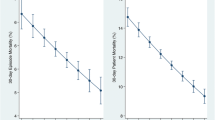Abstract
Objective of this study is to evaluate the selection of patients to be admitted to a hospital medical short-stay unit (SSU) where acute medical admissions with a predicted length of stay of between 24 and 72 h are managed. This is a retrospective observational study evaluating outcomes of all admissions to the medical SSU between January 2005 and December 2008. Factors that influence inappropriate allocation of patients to the SSU or alternative longer stay medical units were evaluated. Length of stay (LOS), mortality, Charlson score, admission to intensive care unit (ICU) (from the SSU), discharge diagnosis, and 7-day readmission rate were analysed. Over 4 years, 45% of the general medical inpatient take, 9,125 admission episodes, were managed by the medical SSU. On an average, 72% of these admissions to the SSU stayed fewer than 72 h. After excluding in-hospital deaths, there were 8,381 admissions to the general medical unit discharged within 72 h, and 77% of these were managed by the SSU during the study period. Inappropriate admissions to the SSU (LOS more than 72 h) tended to be older patients with more complex medical comorbidities. Other factors contributing to prolonged stay in the SSU included weekend admissions, and transfers to the ICU. The 7-day readmission rate was low at 3%; the all-cause hospital mortality for patients admitted to the medical SSU was 2% despite a 32% increase in workload in the medical SSU over these 4 years. In the context of fixed resources and a steeply increasing patient workload, a large proportion of general medical patients can be managed in a medical SSU with the majority being discharged home within 72 h while keeping all-cause in-hospital mortality and readmission rates low. More accurate identification of appropriate patients on admission by using a physiological clinical score and addressing operational issues particularly on weekends could lead to a more efficient SSU.

Similar content being viewed by others
References
Downing H, Scott C, Kelly C (2008) Evaluation of a dedicated short-stay unit for acute medical admissions. Clin Med 8:18–20
Lucas BP, Kumapley R, Mba B, Nisar I, Leek K, Otori-Ntow S, Borkowsky S, Asmar A, Lewis T, Bienias JL (2009) A hospitalist-run short-stay unit: features that predict length-of-stay and eventual admission to traditional inpatient services. J Hosp Med 4:276–284
Abenhaim HA, Kahn SR, Raffoul J, Becker MR (2000) Program description: a hospitalist-run, medical short-stay unit in a teaching hospital. CMAJ 163:1477–1480
Gouin S, MacArthur C, Parkin PC, Schuh S (1997) Effect of a pediatric observation unit on the rate of hospitalization for asthma. Ann Emerg Med 29:218–222
Jones A, O’Driscoll K, Luke LC (1995) Head injuries and the observation ward. J Accid Emerg Med 12:160–161
Gaspoz JM, Lee TH, Weinstein MC, Cook EF, Goldman P, Komaroff AL, Goldman L (1994) Cost-effectiveness of a new short-stay unit to “rule out” acute myocardial infarction in low risk patients. J Am Coll Cardiol l24:1249–1259
O’Connell TJ, Bassham JE, Bishop RO, Clarke CW, Hullick CJ, King DL, Peek CL, Verma R, McGrath KM, Ben-Tovim DI (2008) Clinical process redesign for unplanned arrivals in hospitals. Med J Aust 188:S18–S22
Charlson ME, Pompei P, Ales KL, MacKenzie CR (1987) A new method of classifying prognostic comorbidity in longitudinal studies: development and validation. J Chronic Dis 40:373–383
Quan H, Sundararajan V, Halfon P, Fong A, Burnand B, Luthi JC, Saunders LD, Beck CA, Feasby TE, Ghali WA (2005) Coding algorithms for defining comorbidities in ICD-9-CM and ICD-10 administrative data. Med Care 43:1130–1139
Australian Government Department of Health and Ageing (2010) Casemix Classifications. Australian Refined Diagnosis Related Groups (AR-DRGs), definitions manual. http://www.health.gov.au/internet/wcms/publishing.nsf/Content/healthcasemix-defman1.htm. Accessed 31 May 2010
Owens PL, Barrett ML, Gibson TB, Andrews RM, Weinick RM, Mutter RL (2010) Emergency department care in the United States: a profile of national data sources. Ann Emerg Med 56:150–165
McNeill G, Brahmbhatt DH, Prevost AT, Trepte NJ (2009) What is the effect of a consultant presence in an acute medical unit? Clin Med 9:214–218
Rochon P, Katz JN, Morrow LA, McGlinchey-Berroth R, Ahlquist MM, Sarkarati M, Minaker KL (1996) Comorbid illness is associated with survival and length of hospital stay in patients with chronic disability. A prospective comparison of three comorbidity indices. Med Care 34:1093–1101
Paterson R, MacLeod DC, Thetford D, Beattie A, Graham C, Lam S, Bell D (2006) Prediction of in-hospital mortality and length of stay using an early warning scoring system: clinical audit. Clin Med 6:281–284
Bell CM, Redelmeier DA (2004) Waiting for urgent procedures on the weekend among emergently hospitalized patients. Am J Med 117:175–181
Earnest A, Chen MIC, Seow E (2006) Exploring if day and time of admission is associated with average length of stay among inpatients from a tertiary hospital in Singapore: an analytic study based on routine admission data. BMC Health Serv Res 6:6–10
De La Iglesia F, Valiño P, Pita S, Ramos V, Pellicer C, Nicolás R, Diz-Lois F (2002) Factors predicting a hospital stay of over 3 days in patients with acute exacerbation of chronic obstructive pulmonary disease. J Intern Med 251:500–507
Horwich TB, Hernandez AF, Liang L, Albert NM, LaBresh KA, Yancy CW, Fonarow GC (2009) Weekend hospital admission and discharge for heart failure: association with quality of care and clinical outcomes. Am Heart J 158:451–458
Ananthakrishnan AN, McGinley EL, Saeian K (2009) Outcomes of weekend admissions for upper gastrointestinal hemorrhage: a nationwide analysis. Clin Gastroenterol Hepatol 7:296–302
James MT, Wald R, Bell CM, Tonelli M, Hemmelgarn BR, Waikar SS, Chertow GM (2010) Weekend hospital admission, acute kidney injury and mortality. J Am Soc Nephrol 21:845–851
Conflict of interest
None.
Author information
Authors and Affiliations
Corresponding author
Rights and permissions
About this article
Cite this article
Yong, T.Y., Li, J.Y.Z., Roberts, S. et al. The selection of acute medical admissions for a short-stay unit. Intern Emerg Med 6, 321–327 (2011). https://doi.org/10.1007/s11739-010-0490-6
Received:
Accepted:
Published:
Issue Date:
DOI: https://doi.org/10.1007/s11739-010-0490-6




